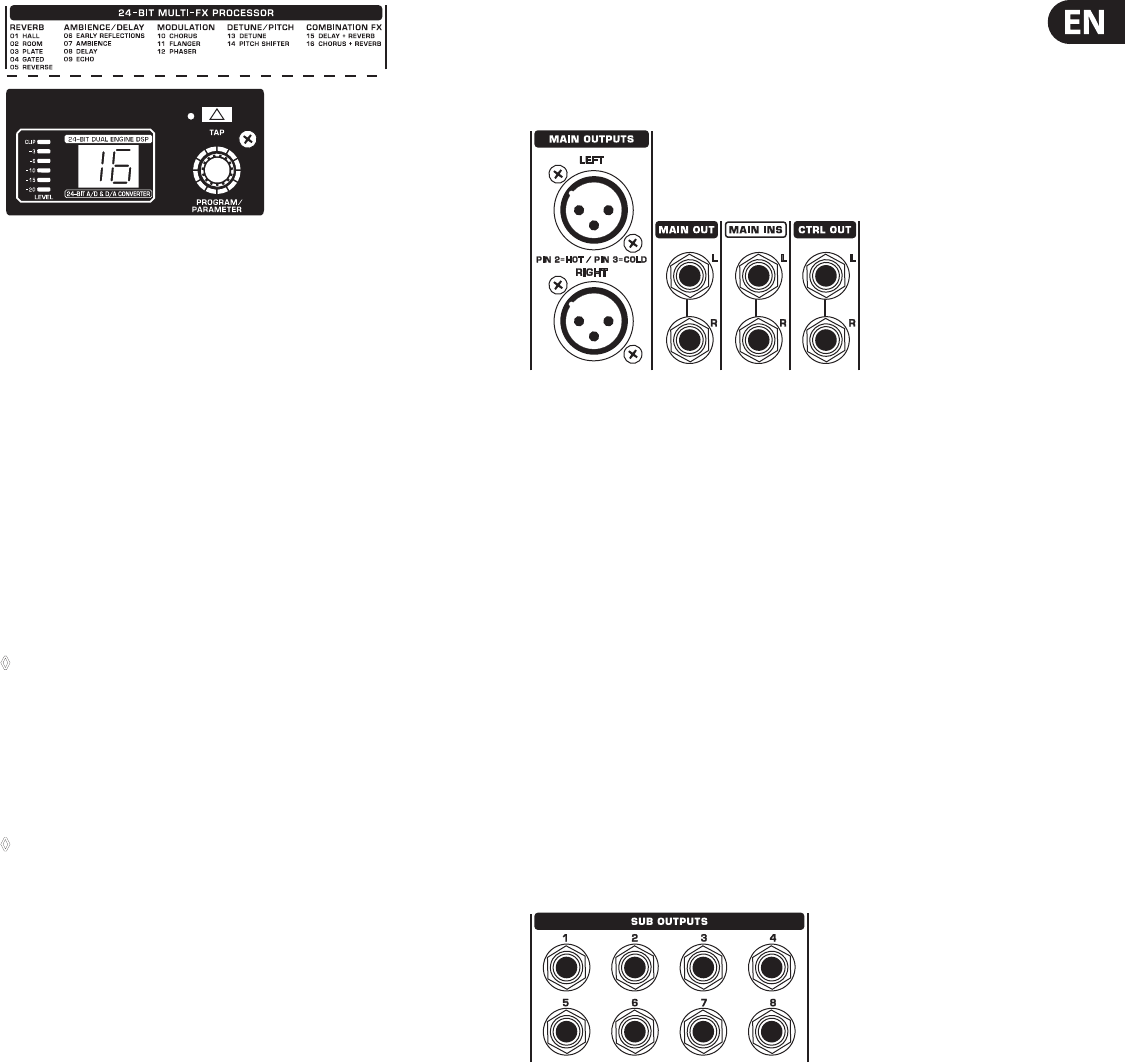
15 XENYX X1622USB/X1832USB/X2222USB/X2442USB User Manual
behringer.com
Digital eects moduleFig. 4.1:
The built-in stereo eects processor has the advantage that it does not need to
be wired up. This excludes the danger of humming or level mismatch right from
the start and thus considerably facilitates use.
These eect presets are classical “mixing eects”. If you move the STEREO
AUX RETURN FX control, you mix the channel signal (dry) and the eect signal.
You can control the balance between the two signals with the channel fader
and the STEREO AUX RETURN FX control.
FX OUT
Mixing consoles X2222USB and X2442USB have a separate output for the eects
device, which is unbalanced and stereo (tip = left signal; ring = right signal;
sleeve = ground/shielding). Thus, you can record, for example, a vocal track
enhanced with reverb in parallel to a “dry” vocal track; when doing the mix-down
later on, you can freely determine the amount of reverb added.
The X2442USB has the effect output on the rear, X2222USB has it ◊
located next to the aux sends on the front panel.
FX FOOTSW.
Connect a standard foot switch to the foot switch jack and use this to switch
the eects processor on and o. A light at the bottom of the display indicates
wheater the eects processor has been muted by the foot switch.
In Chapter 6.2 you will find an illustration showing how to connect ◊
your foot switch correctly.
LEVEL
The LED level meter on the eects module should display a suciently high
level. Take care to ensure that the clip LED only lights up at peak levels. If it is
lit constantly, you are overloading the eects processor and this could cause
unpleasant distortion.
PROGRAM
You can select the eect preset by turning the PROGRAM control. The display
ashes with the number of the current preset. To recall the selected preset,
press on the button; the ashing stops. You can also recall the selected preset
with the foot switch.
Rear Panel Connectors5.
Main mix outputs, insert points and 5.1
control room outputs
Main Mix outputs, main mix insert points and control room outputsFig. 5.1:
MAIN OUTPUTS
The MAIN outputs carry the MAIN MIX signal and are on balanced XLR jacks
with a nominal level of +4 dBu. In parallel with this, ¼" phone jacks carry the
main mix signal in a balanced format (X1622USB: here, the phone jack outputs
are unbalanced and located on the front panel).
CONTROL ROOM OUTPUTS (CTRL OUT)
The control room output is normally connected to the monitoring system in
the control room and carries the stereo mix or, when selected, the solo signals.
MAIN INS(ERTS) (X2442USB only)
These are the insert points for the main mix. In the signal path, they are
post-main mix amp, but pre-main fader(s). Use them to insert, for example,
a dynamics processor or graphic equalizer. Please also note the information
on insert points in chapter 5.3.
Subgroup outputs5.2
Subgroup outputsFig. 5.2:
SUB OUTPUTS
The subgroup outputs are unbalanced and provide the mix of those channels
assigned to each subgroup with the SUB switch (X2442USB: switches 1-2 or
3-4) next to the channel faders. Thus, you can, for example, route a subgroup
to a second console or use the output as a recording output in parallel to
the main outputs. In this way, you can record several tracks simultaneously.
With an 8-track recorder, use Y cables and wire the inputs of your machine
so that you have 2 x 4 tracks available (e.g. channel 1 to track 1 and 2, etc.).
In the rst pass, you can record the tracks 1, 3, 5 and 7, in the second the
tracks 2, 4, 6 and 8.
The XENYX 2442FX already has subgroup outputs wired in parallel (1-5, 2-6, etc.).
X1832USB
X2442USB


















